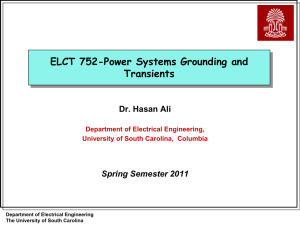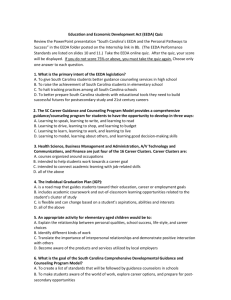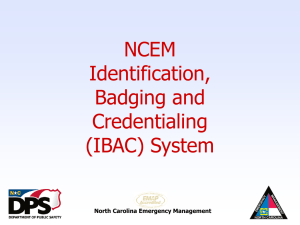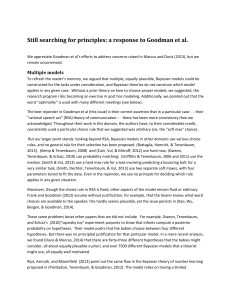Governor signs new legislation that will sharpen schools` focus on
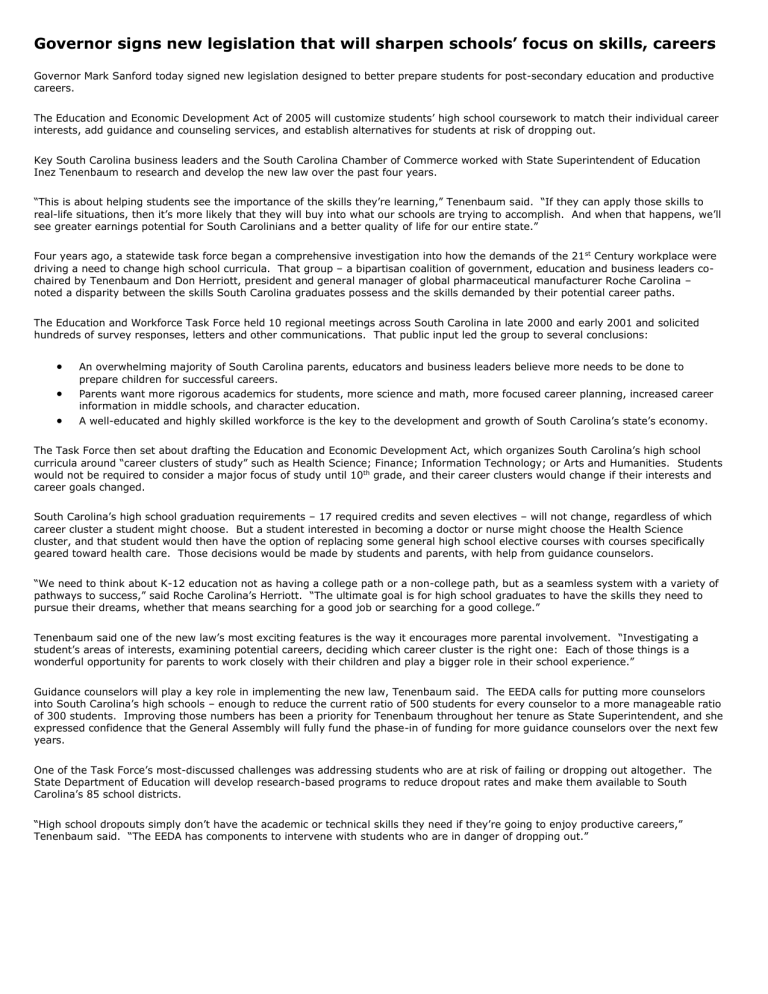
Governor signs new legislation that will sharpen schools’ focus on skills, careers
Governor Mark Sanford today signed new legislation designed to better prepare students for post-secondary education and productive careers.
The Education and Economic Development Act of 2005 will customize students’ high school coursework to match their individual career interests, add guidance and counseling services, and establish alternatives for students at risk of dropping out.
Key South Carolina business leaders and the South Carolina Chamber of Commerce worked with State Superintendent of Education
Inez Tenenbaum to research and develop the new law over the past four years.
“This is about helping students see the importance of the skills they’re learning,” Tenenbaum said. “If they can apply those skills to real-life situations, then it’s more likely that they will buy into what our schools are trying to accomplish. And when that happens, we’ll see greater earnings potential for South Carolinians and a better quality of life for our entire state.”
Four years ago, a statewide task force began a comprehensive investigation into how the demands of the 21 st Century workplace were driving a need to change high school curricula. That group – a bipartisan coalition of government, education and business leaders cochaired by Tenenbaum and Don Herriott, president and general manager of global pharmaceutical manufacturer Roche Carolina – noted a disparity between the skills South Carolina graduates possess and the skills demanded by their potential career paths.
The Education and Workforce Task Force held 10 regional meetings across South Carolina in late 2000 and early 2001 and solicited hundreds of survey responses, letters and other communications. That public input led the group to several conclusions:
An overwhelming majority of South Carolina parents, educators and business leaders believe more needs to be done to prepare children for successful careers.
Parents want more rigorous academics for students, more science and math, more focused career planning, increased career information in middle schools, and character education.
A well-educated and highly skilled workforce is the key to the development and growth of South Carolina’s state’s economy.
The Task Force then set about drafting the Education and Economic Development Act, which organizes South Carolina’s high school curricula around “career clusters of study” such as Health Science; Finance; Information Technology; or Arts and Humanities. Students would not be required to consider a major focus of study until 10 th career goals changed.
grade, and their career clusters would change if their interests and
South Carolina’s high school graduation requirements – 17 required credits and seven electives – will not change, regardless of which career cluster a student might choose. But a student interested in becoming a doctor or nurse might choose the Health Science cluster, and that student would then have the option of replacing some general high school elective courses with courses specifically geared toward health care. Those decisions would be made by students and parents, with help from guidance counselors.
“We need to think about K-12 education not as having a college path or a non-college path, but as a seamless system with a variety of pathways to success,” said Roche Carolina’s Herriott. “The ultimate goal is for high school graduates to have the skills they need to pursue their dreams, whether that means searching for a good job or searching for a good college.”
Tenenbaum said one of the new law’s most exciting features is the way it encourages more parental involvement. “Investigating a student’s areas of interests, examining potential careers, deciding which career cluster is the right one: Each of those things is a wonderful opportunity for parents to work closely with their children and play a bigger role in their school experience.”
Guidance counselors will play a key role in implementing the new law, Tenenbaum said. The EEDA calls for putting more counselors into South Carolina’s high schools – enough to reduce the current ratio of 500 students for every counselor to a more manageable ratio of 300 students. Improving those numbers has been a priority for Tenenbaum throughout her tenure as State Superintendent, and she expressed confidence that the General Assembly will fully fund the phase-in of funding for more guidance counselors over the next few years.
One of the Task Force’s most-discussed challenges was addressing students who are at risk of failing or dropping out altogether. The
State Department of Education will develop research-based programs to reduce dropout rates and make them available to South
Carolina’s 85 school districts.
“High school dropouts simply don’t have the academic or technical skills they need if they’re going to enjoy productive careers,”
Tenenbaum said. “The EEDA has components to intervene with students who are in danger of dropping out.”



